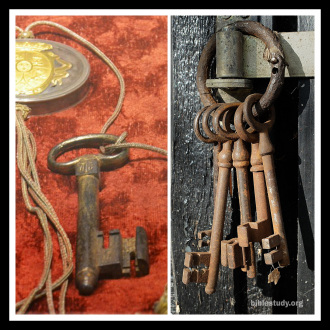The key of David appears only twice in the Bible. The first time it appears is in Revelation where it states, "To the angel of the church in Philadelphia write . . . who holds the KEY OF DAVID" (Revelation 3:7). The speaker is the resurrected Jesus, whom John sees in a vision, and the message is to the church at Philadelphia. The possession of this key by Christ is used as proof that the One addressing the church is God, "the Holy One, the One Who is true."
The second occurrence of the key of David is in the book of Isaiah the prophet where it states, "And the key of the house of David will I lay upon his shoulder (Eliakim as an allusion or type of Christ); so he shall open, and none shall shut; and he shall shut, and none shall open" (Isaiah 22:22, KJV).
Biblically Unclear
Unfortunately, Scripture does not directly answer our question regarding the key of David. There is a lot of conjecture and supposition on this subject but one should understand that the Bible does not specifically identify this object.

The one thing that made David unique was the promise God made to him. The Eternal, speaking through the prophet Jeremiah, prophesied of one of his descendants who would bring salvation and confirm His covenant with all.
"Behold, the days come," says the Lord, "that I will establish the good thing which I have promised to the house of Israel and to the house of Judah. In those days, and at that time, I will cause the Branch of Righteousness to grow up to David. And He shall execute judgment and righteousness in the land." . . .
"Then I will cast away the seed of Jacob, and David My servant, so that I will not take any of his seed to be rulers over the seed of Abraham, Isaac, and Jacob. But I will bring them back from their captivity, and have mercy on them." (Jeremiah 33:14 - 15, 26, HBFV).
Some have speculated that the covenant made to David would require a physical descendent to be ruling over at least some portion of Israel down to our present time. One explanation of this can be found in the book "Judah's Scepter and Joseph's Birthright" written by J. H. Allen. He makes a powerful case for the lineage of rulers existing today.
Symbolism
A key was often worn on the shoulder of those who possessed official authority and power (see Isaiah 22). This symbolism is reiterated in the New Testament as well.
Jesus, in the book of Revelation, is said to possess several keys that unlock death and hades (or the grave, see Revelation 1:18). An angel, also in Revelation, is given one to lock the spiritual cell or "bottomless pit" where a bound Satan will be constrained for one thousand years (Revelation 20:1).
This evidence points to a key representing, at least figuratively, the possession of power and has nothing whatsoever to do with Biblical prophecy.
Thankfully, Jesus and His apostles have given us the plan of salvation, a salvation that does not depend on some mysterious key of David or our interpretation of what it is or represents. It is, indeed, one of the most fascinating areas of study in the Bible but we should not claim to know for certain what this means. Each of us will have to decide for himself the spiritual meaning of this object.